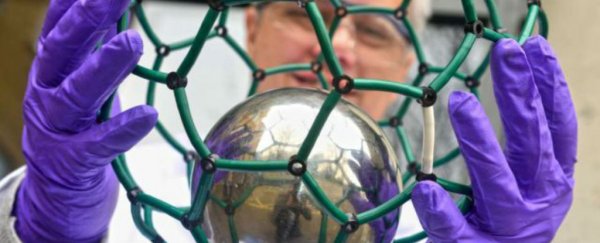If your life's ambition is to become very, very rich, consider getting into the business of producing endohedral fullerenes - the world's most expensive material.
Scientists at Oxford University in the UK announced that a spin-off lab called Designer Carbon Materials is now producing endohedral fullerenes, and they recently sold off their first sample of the material to the tune of $US32,000 for 200 micrograms (1 microgram = one-millionth of a gram), which is about one-fifteenth the weight of a snowflake, or one-third the weight of a human hair.
First discovered in 1985, endohedral fullerenes are spherical carbon nanostructures that consist of a sturdy fullerene cage made from 60 carbon atoms, inside which the atoms of non-metals or simple molecules, such as nitrogen, phosphorus, and helium, are trapped.
These things aren't just outrageously expensive curiosities - when they contain nitrogen atoms, they actually have the potential to change how we keep time, because of their extra long electron spin lifetime.
Scientists are now investigating the possibility of using them in atomic clocks - the most accurate time-keeping systems in the world - and the Oxford team expects that in the future, they could be used to make all kinds of devices more accurate than ever.
This is because endohedral fullerenes have the potential to downsize atomic clocks from the size of a cabinet to a microchip, so we could install them in our phones or integrate them with our GPS devices, for example.
If we can figure out how to do that, says Doug Bolton at The Independent, we could have GPS devices that are accurate to within 1 millimetre. That's pretty mind-blowing, when you consider that current GPS devices are accurate to around 1 to 5 metres.
"At the moment, atomic clocks are room-sized. This endohedral fullerene would make it work on a chip that could go into your mobile phone," Lucius Cary, director of the Oxford Technology SEIS fund - which holds a minor stake in Designer Carbon Materials - told Rebecca Burn-Callander at The Telegraph.
"There will be lots of applications for this technology," he added. "The most obvious is in controlling autonomous vehicles. If two cars are coming towards each other on a country lane, knowing where they are to within 2 metres is not enough, but to 1 mm it is enough."
The only other material on Earth that could rival the astronomical cost of endohedral fullerenes is antimatter, which NASA estimates would cost about US$61 trillion per gram, but no one's in the business of producing antimatter to sell off commercially just yet.
We're still several years away from mini atomic clocks going into our portable devices, but Designer Carbon Materials founder, Kyriakos Porfyrakis, told Andrii Degeler at Ars Technica that the consortium of UK and US researchers that bought their first sample of endohedral fullerene is on the case.
